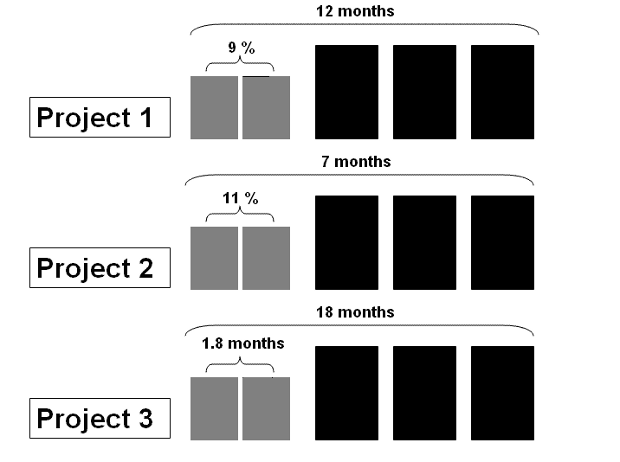
More companies than ever are seeking to understand project accounting costs as they realizethat knowledge of this data impacts their bottom line and exposes areas where costs can be cutand profits can be made. By understanding project accounting costs, companies can discoverfinancial problems with projects early on and fix them. This can potentially save millions of dollars.But just because companies seek to understand these costs doesn’t mean they know the bestway to go about finding the information.
Say, for example, that Company XYZ decides to pay more attention to project financials anddiscovers an out-of-control project. Maybe Company XYZ can do something about it — like cancelthe project, put different resources on it, or change the scope. Or maybe they didn’t discover theproblem until it was too late to save the project, because they missed some key steps.
Projectsthat get rescued often do so because they have accurate project accounting cost data, whichallows for discovery of the problem early enough to fix it. Read on to find out how to manage yourproject accounting costs accurately.
1. Understand That Time Is Money
To understand project costs, you have to know who worked on the project and for how long.This is achieved through a good time-tracking system. Time-tracking data (payroll, billing, projectmanagement, and strategy) feeds a number of operations:
- Project cost accounting – How much have we spent?
- Tracking – Are we done yet?
- Management – What should we do next?
- Estimation improvement – How much is this going to cost us?
Tracking time is often viewed with a somewhat negative connotation. At best, it is a necessary,though disliked, factor in the determination of wages and billing. At worst, it is seen as a method ofkeeping employees under totalitarian scrutiny, a waste of time, and inefficient. However, the truthis that time tracking, when instituted properly, can have massive financial benefits for a companyand for its individual employees.
2. Use Key Performance Indicators to Measure Intermittent Success
A key performance indicator, or KPI, measures an organization’s progress toward a strategicgoal. When leveraged correctly, KPIs can make a huge impact. “Percentage of projectsprofitable” is a KPI that can really affect your business in a positive way.
As an analogy, considerBritish Petroleum and its experiences in drilling for oil. BP created a strategic vision for thecompany called “no dry holes.” Drilling for oil and not finding it is expensive. Rather than try tomake up for all the dry holes by finding an occasional gusher, BP decided to try to never have adry hole in the first place. Changing the attitude that dry holes were an inevitable cost of doingbusiness fundamentally changed its culture in very positive ways.
If you set a strategic goal for your company of “no unprofitable projects,” it will change the natureof discussions in your business. For example, it empowers frontline employees to legitimatelypush back when a project is being taken on for political reasons. Conversely, having the attitudethat the winners will make up for the losers doesn’t do this.
Measuring this KPI is easy, because you can obtain direct per-project cost data from yourtimesheet system. Correctly applying indirect data (such as sales or accounting time) to the directcosts is a bit more complicated. Connecting all of this to revenue data gives you per-projectprofitability. Once you have that data, you can work on your KPI of percentage of profitableprojects to try to maximize it. The formula for this KPI for a given time period (usually a quarter ora year): # of profitable projects/# of projects
3. Estimate Accurately and Adhere to Your Estimates
Many companies do a poor job of bidding projects appropriately. In order to avoid underbiddingor overbidding, you can use the formula [(E-A)/E]:
E = Estimated hours to complete projectA = Actual hours used to complete project
Improving this number can be difficult for some companies until they understand a simple truth:Similar projects often have a strikingly similar ratio of early phase cost to overall project cost. Theearly phases of a project are usually referred to as the “requirements,” “design,” or “specification”phases. If after carefully tracking time on a batch of similar projects, you find that the first twophases usually take about 10 percent of the total project time, you can then use that data to predict thelength of future projects.
The following diagram shows how tracking the time it takes to complete a project helps inplanning future projects. By tracking time and subsequently learning that the first two phasesof Projects 1 and 2 took approximately 10 percent of all project time to complete, the projected lengthof Project 3 becomes easy to determine. If the first two phases of Project 3 take 1.8 months tocomplete, you can estimate that the entire project will be completed in 18 months. This projectestimation technique has proven itself to be extremely accurate for similar projects in a variety ofcompanies.

4. Quality Data In = Quality Data Out
In order for project accounting data to be accurate, the data that is put into the system must be accurate. Employees are often resistant to the idea of tracking their time for all of their activities. This is understandable; no one has ever gotten a promotion for their exemplary ability to fill out a timesheet. However, the value of this data is tremendous if you need to look back into a project’s activities or budget or timeline.
Employees need to understand that there are tangible benefits to tracking their time. Without tracking time to specific projects, it is impossible to calculate the real worth of their time and the real value of their contributions to the project. Additionally, not providing accurate time-tracking information will skew the accounting data for the entire project.
Bad project accounting leads to unnecessary overtime, stressful, blown schedules, bad estimatesand canceled projects. Citing specific examples from your company’s history when accuratetime collection could have made things easier for your employees helps to get them on board.
Tying bonuses or other benefits to complete data collection is often used in customer relationshipmanagement tools to adjust sales commissions. The same can be done for other forms ofdata collection. Even if you don’t like to dangle a carrot to get results, providing employees with atemplate for future success can prove the value of accurate time and resource tracking.
5. Limited Visibility
Any project time-tracking system that is worth its salt will be able to limit an employee ordepartment’s visibility into the project list. An employee confronted with 500 entries will usually enter bad data on a timesheet. Pushing this burden up to an administrator will vastlyimprove data accuracy.
You can also use this mechanism to assign people to projects, limit hours on projects, and seewho has been assigned to which tasks. Timesheet systems are unlikely to be as fully functional indrawing Gantt charts as systems like Microsoft Project, but can be integrated with those systemsfor the departments that absolutely require it.
Time, money, and resources need to be precisely applied in order to achieve the best resultsin any project setting. Fortunately, the tools exist to make the determination of that amountrelatively simple. This common-sense approach can make the entry and application of projectdata seamless and simple.
















































Social CRM
See all Social CRM